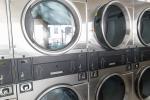OAKBROOK TERRACE, Ill. — A trio of self-service laundry operators described in some detail why the unattended store model best fits their business plan and lifestyle during a recent Coin Laundry Association webinar.
In “The Unattended Laundromat: Making That Business Model Work in 2023,” Kevin Beggs (no relation to the author) of Massachusetts, Casey Wright of Minnesota and Brian Brunckhorst of Texas spoke about their operations and answered questions from the audience.
Beggs owns and operates nine unattended stores; his father started the company 54 years ago.
“Now, sometimes I hesitate to tell people that it’s been 54 years because we’re still trying to figure some things out,” he says. “The point is we’re still trying and so that’s what keeps me busy.
“At one point, we had 12 stores but now nine is enough. And we run them unattended. That’s why we’re all here. I prefer to call them ‘self-service.’ Unattended is something that we aren’t. Self-service means people have an opportunity to serve themselves.”
Casey Wright is the operations manager for a group of nine Maytag Laundries in the Upper Midwest. “We were up to 12 at one point but we’re back to nine now. We’re into north-central Minnesota and then to Wisconsin. Our stores are about 150 miles apart, from furthest north to furthest south. I’ve been in the business since 1994. … All our stores are unattended, and have been since day one.”
Brian Brunckhorst previously called California home but now lives in Texas. His seven Advantage Laundry locations are split between the two states, with five in the San Francisco Bay area and two in the Dallas-Fort Worth area. Just one of the seven, a California location, is unattended.
“I’ve done both sides of the operation, and hope to be able to give you my take on that,” he says.
WHY UNATTENDED?
“We certainly have seen the trends and mode of operation ebb and flow over time,” CLA CEO Brian Wallace says of his association’s annual surveys on store operations. “Most recently, the last four or five years, it’s 40% to 50% fully attended. The unattended, or self-service only, would be in that 15-20% (range) most years, with the balance being … partially attended, where you’ve got somebody there, just not during all hours of operation.”
He asked the panel what factors went into their decision to operate at least some of their stores as unattended.
“My dad started our company and he was the one who decided to start with his first store completely unattended. And he made it work for his second, third,” Beggs says. “I joined my dad getting out of college and we built it up from six to 10 stores and had never run a store other than unattended. It’s the only way I know how to run ’em.”
“We’re in pretty small towns,” says Wright. “Most of our stores, the cities are 5,000, 10,000 people. … A lot of what dictated it in the beginning was pretty much a lack of sales. There’s not enough sales in a small town to justify having someone there all the time.”
“My rule is that if your laundry is making $15,000 gross a month or less, it probably should be unattended,” Brunckhorst says. “You don’t really have enough money in there to afford even a part-time attendant, you know. So you hire an independent contractor and have it unattended.
“If you’re between $15,000 and say, $25,000, maybe partly attended, and anything over 25, it’s busy enough, machines are getting dirty—cleanliness is important—so you know, maybe that’s when you go fully attended.”
In Thursday’s conclusion: Continuity of services; communications and customer service
Have a question or comment? E-mail our editor Bruce Beggs at [email protected].


